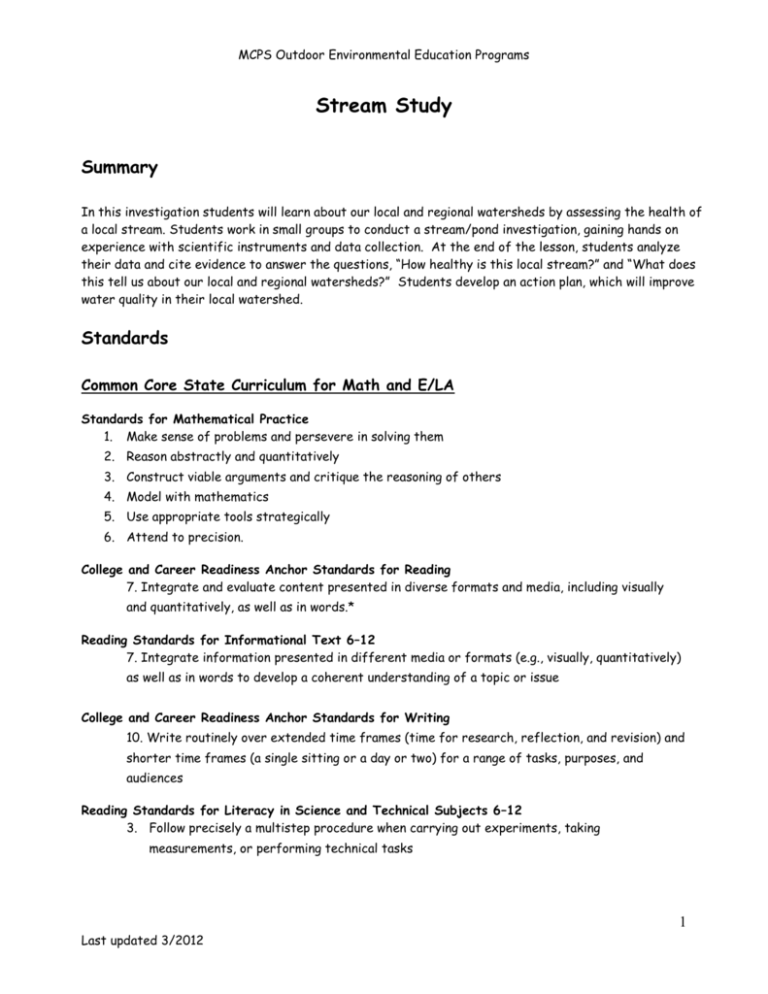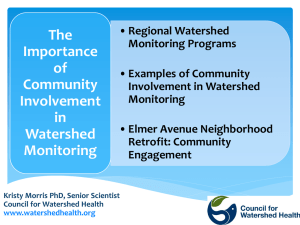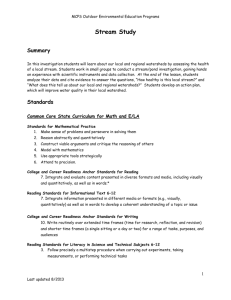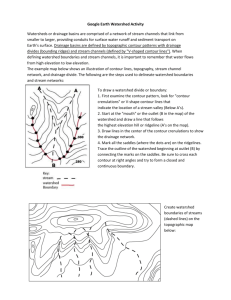STREAM STUDY - Montgomery County Public Schools
advertisement

MCPS Outdoor Environmental Education Programs Stream Study Summary In this investigation students will learn about our local and regional watersheds by assessing the health of a local stream. Students work in small groups to conduct a stream/pond investigation, gaining hands on experience with scientific instruments and data collection. At the end of the lesson, students analyze their data and cite evidence to answer the questions, “How healthy is this local stream?” and “What does this tell us about our local and regional watersheds?” Students develop an action plan, which will improve water quality in their local watershed. Standards Common Core State Curriculum for Math and E/LA Standards for Mathematical Practice 1. Make sense of problems and persevere in solving them 2. Reason abstractly and quantitatively 3. Construct viable arguments and critique the reasoning of others 4. Model with mathematics 5. Use appropriate tools strategically 6. Attend to precision. College and Career Readiness Anchor Standards for Reading 7. Integrate and evaluate content presented in diverse formats and media, including visually and quantitatively, as well as in words.* Reading Standards for Informational Text 6–12 7. Integrate information presented in different media or formats (e.g., visually, quantitatively) as well as in words to develop a coherent understanding of a topic or issue College and Career Readiness Anchor Standards for Writing 10. Write routinely over extended time frames (time for research, reflection, and revision) and shorter time frames (a single sitting or a day or two) for a range of tasks, purposes, and audiences Reading Standards for Literacy in Science and Technical Subjects 6–12 3. Follow precisely a multistep procedure when carrying out experiments, taking measurements, or performing technical tasks 1 Last updated 3/2012 MCPS Outdoor Environmental Education Programs 7. Integrate quantitative or technical information expressed in words in a text with a version of that information expressed visually (e.g., in a flowchart, diagram, model, graph, or table) Writing Standards for Literacy in History/Social Studies, Science, and Technical Subjects 6–12 1. Write arguments focused on discipline-specific content. b. Support claim(s) with logical reasoning and relevant, accurate data and evidence that demonstrate an understanding of the topic or text, using credible sources. Science State Curriculum 1.A.1 design, analyze, or carry out simple investigations and formulate appropriate conclusions based on data obtained or provided 1.A.1.g give reasons for the importance of waiting until an investigation has been repeated many times before accepting the results as correct 1.A.1.h use mathematics to interpret and to communicate data 1.B.1.d describe the reasoning that led to the interpretation of data and conclusions drawn 3.F.1 give reasons supporting the fact that the number of organisms an environment can support depends on the physical conditions and resources available 3.F.1.a explain that populations increase or decrease relative to the availability of resources and the conditions of the environment 6.B.1 recognize and explain that human-caused changes have consequences for Maryland’s environment as well as for other places and for future times 6.B.1.c identify and describe that ecosystems can be impacted by human activities Enduring Understandings - Scientists must use many indicators to assess the health of stream habitat. Scientists use a variety of tools and procedures to gather and to share data. Human activities in the local watershed can impact the health of the greater watershed. Children and adults can take action to improve water quality. Essential Questions What is a watershed? How can you determine if your local watershed is healthy? How healthy IS the local stream? How can you be a good steward of the environment? Vocabulary abiotic, benthic, biotic, dissolved oxygen (D-O), ecosystem, erosion, impermeable, impervious, nitrates, nutrients, permeable, pervious, pH (acid, base/alkaline), sediment, toxins, tributary, watershed, physical characteristics (flow, clarity, stream buffer, temperature), chemical characteristics (D-O, pH, nitrates), aquatic invertebrates and insects, aquatic vegetation 2 Last updated 3/2012 MCPS Outdoor Environmental Education Programs Materials Bay watershed map State map County map Critter Retention Trays (CRT) Nets of varying sizes (hand, bait, D-nets) Bucket Magnifiers – hand lenses, 2-way viewers Macro-invertebrate ID chart with taxa groupings Other ID support (books, charts, etc.) Measuring tape (50 ft) pH strips pH chart Dissolved Oxygen (DO) kit Thermometer Data sheet Mastery Objectives By the end of this lesson, students will be able to: conduct various tests and examine various indicators to determine the health of a local stream. list potential sources of pollution in a local tributary of the Chesapeake Bay. identify examples of how human activities may have negative or positive consequences on the watershed. identify food chains within the stream ecosystem. Engage (15 - 20 minutes) Watershed Background (15-20 minutes) Our task today is to find out how healthy this local stream is! Why do we care? What is a watershed? - What is our local watershed? - States in CB watershed (inc. DC) - Over 100,000 streams in watershed - Drains more water than the Great Lakes - Locate local watersheds - Diagram flow of water to Chesapeake Bay – note names of creeks, streams, rivers; and smaller to larger pattern - Development – roads, homes, businesses and impact on watershed 3 Last updated 3/2012 MCPS Outdoor Environmental Education Programs How can you determine if a local stream is healthy? What observations can we make? What data can we collect? - Temperature - pH - Dissolved Oxygen - Biotic Index - Stream Bottom and Buffer Analysis - Pervious and impervious surfaces - Surrounding land use How to collect data (15 – 20 minutes) Teacher demonstrates: (Refer to teacher resource materials for detailed procedures.) - use of nets, containers, pH test strips, D-O kits, magnifiers - handling of animals - identification of animals and taxa placement - review of physical characteristics – buffer, erosion, water clarity, water flow, plant/tree cover; permeable/ impermeable and their impact (positive/negative) - how to use the collection chart to record data! Teacher emphasizes: - appropriate investigations do not negatively impact the habitat - general safe and responsible behaviors Explore (60 – 75 minutes) Stream Investigation: - Divide into groups and pass out equipment. - Take students to the stream study location. - Have students complete tests and gather data – temperature, pH, D-O, flow, stream bottom analysis, stream buffer analysis, clarity, biotic index. - Have students record results. - Take time to show animals discovered with all groups. - Return all animals to original habitat. - Gather equipment and students and return to central location. Explain (15 minutes) Review Results Students share the results they recorded from the various indicators, analyze those observations, and answer the following questions citing evidence from their observations. Is this a healthy watershed? Explain your answer. Do any of the indicators reflect the possibility of a problem? What factors might be influencing the health of this stream/pond? Could the water quality be improved? How? 4 Last updated 3/2012 MCPS Outdoor Environmental Education Programs Evaluate Complete the reflection questions (in their journal if applicable): 1. How would you rate the health of the stream and what data do you have to back it up? 2. What activities could we do in the areas surrounding the stream to improve the condition? Describe at least 2 and give reasons to support your answers. 3. Draw a food chain with at least 3 organisms from the stream. 4. How do you think the stream quality of this stream compares to the quality of a stream in your neighborhood? Provide at least three specific examples. Extend Students complete another stream study close to their home school, or some other location and compare their data with the data collected at Outdoor Education. Students review data from other local streams from the DEP website and compare with the data collected at Outdoor Education. http://www.montgomerycountymd.gov/deptmpl.asp?url=/content/dep/Watershed/home.asp See Teacher Resource: “Extension Activities and Action Projects” from We All Live Downstream, MCPS 5 Last updated 3/2012







